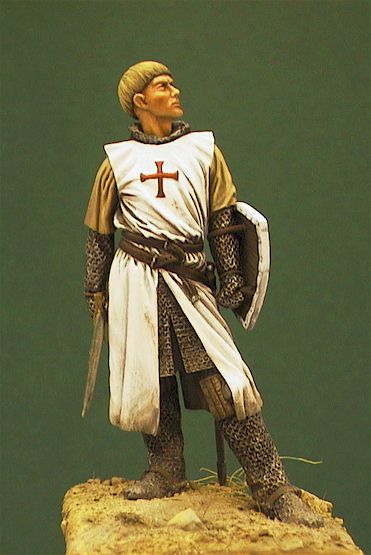model by Magnus Löfqvist
text and images by Martin Waligorski
Few events shaped the evolution of medieval Europe to such an extent as the Crusades.  The Crusades began in the late eleventh century and lasted several hundred years. They inspired the most dedicated valor, the most bloodthirsty cruelty, and the greediest vandalism of medieval men.
The Crusades began in the late eleventh century and lasted several hundred years. They inspired the most dedicated valor, the most bloodthirsty cruelty, and the greediest vandalism of medieval men.
They also offered the opportunity for fulfilment of Christian ideals of self-sacrifice and Germanic heroic knighthood. A combination of both gave birth to the Knights Templars, the first military order in the Catholic Church. Its meteorite career and the unexpected end in disgrace continues to raise interest even today.
The Templars banded together to protect the helpless on their pilgrimage to the Holy Land. The Templars took vows of poverty, chastity, and obedience and were given headquarters near the ruins of the Temple of Solomon in Jerusalem. A second order, the Hospitalers, was founded soon after the Templars, and was attached to the ancient Hospital of St. John of Jerusalem.
Composed of knights, chaplains, and brothers under the command of a grand master, the two military orders quickly grew to become the most effective fighting forces in the Holy Land. Each had a special uniform: the Templars wore red crosses on a white Cistercian habit, the Hospitalers white crosses on black.
In contrast with their humble beginnings, the Templars rapidly grew to extraordinary power. Enjoying direct protection of the pope and some exorbitant economical and legal privileges, they established firm foothold and many castles in the Kingdom of Jerusalem and in Cyprus, and soon gained universal fame not only for their exploits on the battlefield, but also for an almost unlimited appetite for power, eventually completely loosing sight of their original vows of poverty.
As an army they were never very numerous. A contemporary chronicle tells that there were 400 knights in Jerusalem at the zenith of their prosperity. However, spreading back to medieval Europe, the Templars order eventually amassed as many as 9000 estates and immeasurable wealth. Eventually it gained them many antagonists within the Church itself including the Hospitalers who openly challenged the Templars, the clergy and the French royal court.
On October 13th, 1307, secret orders of king Philip the Fair and the ecclesiastical inquisitors were sent throughout France to arrest all the Templars on the same day. They were accused of denying Christ, worshipping an idol and other acts of abuse performed in the most impenetrable secrecy surrounding their practices. Seven years later, following massive trials, masters of the order were publicly burned in Paris. The pope disbanded the order and warned that anyone thinking of joining would be excommunicated and charged as a heretic.
Due to the secrets that they kept during their existence, and their abrupt downfall, a large number of myths have developed around the Templars.
The figure
Magnus Löfqvist is the author of this 54 mm figure. The figure itself is a white metal kit from Elite Miniaturas from Spain. In common with other items in the Elite’s product line, it represents excellent sculpting and level of detail.
The Elite figure was released as Norman Knight, Antioch 1268, but Magnus thought that it fitted the Templar theme very well. He only raised the knight’s head for a more dynamic pose.
Magnus used artist’s oils for painting of the figure’s face, hair and skin parts. The clothing and the various accessories were painted with acrylics. The red Templar crosses on the figure’s chest and the shield were hand-painted.
The base was modelled from Milliput.
This article was originally published in IPMS Stockholm Magazine in June/July 2004.




